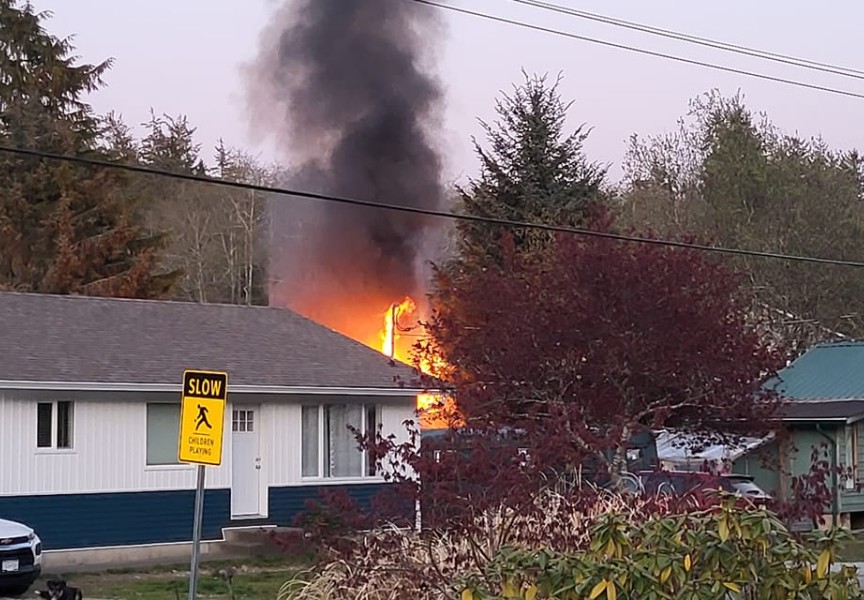Linda Gomez-Seitcher has taken over as Program Coordinator for Enhanced Service Delivery and the First Nations Job Fund within the NTC Health Promotion & Social Development Department and the Nuu-chah-nulth Employment and Training program ( NETP).
Gomez-Seitcher most recently served as Acting K-12 Supervisor for Nuu-chah-nulth education workers. She now takes the helm in the new employment training initiative, mandated by Aboriginal Affairs.
“It’s something I am looking forward to, because I have, in the past, worked as Centre of Excellence Coordinator in Social Development,” she said. “At that time, we were helping all 14 nations meet the [Aboriginal Affairs and Northern Development] Compliance Review, training, assisting with file management and reporting.”
The Enhanced Service Delivery initiative, which was just launched in January, targets on-reserve youth between 19 and 24 years, who are on social assistance.
“With this program, I will be the primary contact, helping to support the different tasks that are involved. That’s pretty exciting, coming up with solutions to help 19- to-24-year-olds find training and employment.”
Enhanced Service Delivery is the first phase in a two-pronged approach to recruiting and training candidates, with funding delivered in two streams.
Gomez-Seitcher’s program covers both streams including the pre-employment phases, which is funded by Aboriginal Affairs and the employment and training phase, which is funded by Human Resources Service Delivery Canada.
NTC case management support workers use two main assessment tools: the University of Rhode Island Change Assessment (URICA) test and the Communications And Math Employment Readiness Assessment (CAMERA) test.
URICA determines whether they are ready for change in their life. Originally used in drug and alcohol services, it has since been adapted to a more general usage.”
The multi-stage testing process is required because many of the clients face multiple barriers to employment, including mental health and addiction issues. To make that leap from non-employment to employment requires a significant change in lifestyle and mindset. Otherwise, trying to determine their career potential would be futile.
URICA measures the candidate’s ability to make that mental shift. Candidates must achieve a prescribed score on URICA before proceeding to CAMERA. If they don’t, they must proceed to the motivational interview.
It works like a conventional job interview, but the motivational interview requires the candidate to undertake a rigorous self-assessment, guided by a case management support worker, in order to determine his or her own best course of action on the road to training or employment.
CAMERA determines each candidate’s levels of literacy and numeracy, with a focus on the workplace.
The candidate then undertakes a Multi-Dimensional Employability Assessment, to determine the sort of barriers they may have, such as addictions or mental health issues. Do they have a criminal record? Do they need a GED (Grade 12 equivalent diploma)?
The assessment also looks at social factors. Do they have adequate housing to be able to maintain a training program? Do they need transportation? Childcare?
At this stage, the candidate puts together an Employment Action Plan. Clients may need life skills training. They may need to upgrade their education. In order to achieve their employment or training goals, they may need to acquire a driver’s license and/or workplace certifications such as First Aid, Boat Operator, etc.
But training also includes workshops to teach appropriate workplace behaviour and conduct in order to make that transition to becoming an employed person.
Participation is mandatory. Anybody 19 to 24 years of age living on-reserve on social assistance is required to take part.
While youth from all 14 Nuu-chah-nulth nations are required to undergo the pre-employment and training programs, each nation has the option to opt in to the Enhanced Service Delivery program component. Currently, seven nations, Yuułuʔiłʔatḥ, Tla-o-qui-aht, Ditidaht, Mowachaht/Muchalaht, Ehattesaht/Chinehkint , Ka:'yu:'k't'h'/Che:k:tles7et'h', and Hupacasath, are enrolled.
And there are time constraints. The life skills component must be completed within six months. Once that phase is complete, the occupational training must be completed within one year.
Gomez-Seitcher’s own life journey makes her uniquely qualified to empathize with and motivate young people seeking to improve their lives. The daughter of the late Lillian Gus, she is by birth a member of Tseshaht First Nation, and last year, in a traditional Nuu-chah-nulth ceremony on Long Beach married Ray Seitcher Jr. of Tla-o-qui-aht.
Her late father, Valentine Perez Gomez Sr, was a Mexican-American from Texas.
“I was born in Portland, Oregon, but I grew up in Seattle,” she said. “My dad was in construction, so we grew up wherever the work was.”
Gomez-Seitcher said both parents stressed the importance of education to their children.
“Both of my parents always read. The house was always filled with all kinds of books. My first memories are of my mom and dad discussing all kinds of topics. So when I went to my first Anthropology class, the professor reminded me of my dad.”
Gomez-Seitcher also learned that Mexican-American people place a priority on education.
“When my grandmother came from Mexico, Mexican children were not allowed to attend the public schools in Texas. She actually taught classes at the church. A lot of people came to her for help because she could speak English.”
Gomez-Seitcher first moved to her home territory when she was 11, following the death of her mother.
“We had visited every summer, and ended up staying.”
A self-professed nerd, she had the tools to maintain good grades, but life took another turn; family came first. She quit school in Grade 11 to work full-time to support her siblings.
“I worked for over 10 years and always regretted not having my Grade 12 diploma. After I had my son, I went back to school. I was only going to get my Grade 12 diploma and found that I really enjoyed it.”
Gomez-Seitcher also undertook retail training through the federal Unemployment (now Employment) Insurance program, and over the years, worked in a number of cities across Canada, including Yellowknife, N.W.T., just 400 kilometres short of the Arctic Circle.
“I held quite a few jobs up there. My last position was at the TD Bank,” she said. “People were really welcoming up there and it was a great place.”
But it was cold, she admitted.
“My first winter up there, I cried,” she said. “When I went up I had my fancy winter boots and my short little ski jacket. By the time I left, I had a big parka and big mukluks and learned the importance of layering clothing.”
Gomez-Seitcher eventually enrolled at Malaspina (now Vancouver Island University) in 2000 and completed her Bachelor of Arts in English in 2004.
But it wasn’t an easy transition at first.
“My first semester at Malaspina didn’t go so well. But I got some support and I joined study groups, and my grades just went up. It was easy, once I found the right program.”
She followed that up with a Provincial Instructor Diploma for adult education. After starting out as a casual in both the NTC Education and Mental Health departments, Gomez-Seitcher joined the new Quu?asa program as Program Coordinator in 2007.
“We started out without funding, so I was coordinating events on a very small budget. That was a good way to find out how to work with the nations and with external organizations, to see how we could all work together, and also learn about the culture.”
Gomez-Seitcher believes that for Enhanced Service Delivery/ First Nations Job Fund to succeed in getting Nuu-chah-nulth youth into the workforce, maintaining clear lines of communication will be critical.
“I think the most important thing is finding out what the people want, and going from there. That’s the most important thing I’ve learned, working with NTC, finding out the needs and wants of the community members.”






